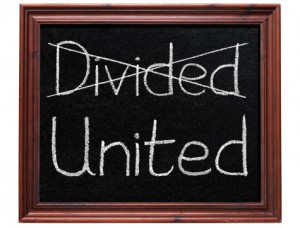Relationship Differences: Fusion and De/fusion (Part 20)
By Asher Crispe: January 24, 2013: Category Inspirations, Quilt of Translations
 Did God create the universe because He was lonely? From a human perspective it would be easy to see it that way, while on another level, it does not seem to be possible, after all (Devarim/Deuteronomy 4:35) “there is no other than Him.” This assertion informs us that even after Creation, after the opening up of an outside and the introduction of an other (especially a human other), God remains alone. To us, the otherness of our existence seems real enough. Are we not separate beings? Yet, we have to come to terms with the notion that not only ourselves, but the entire world, is both real and imaginary (real for us looking ‘up’ at the Creator from the perspective of Creation and imaginary from the Creator’s perspective looking ‘down’ at His Creation).
Did God create the universe because He was lonely? From a human perspective it would be easy to see it that way, while on another level, it does not seem to be possible, after all (Devarim/Deuteronomy 4:35) “there is no other than Him.” This assertion informs us that even after Creation, after the opening up of an outside and the introduction of an other (especially a human other), God remains alone. To us, the otherness of our existence seems real enough. Are we not separate beings? Yet, we have to come to terms with the notion that not only ourselves, but the entire world, is both real and imaginary (real for us looking ‘up’ at the Creator from the perspective of Creation and imaginary from the Creator’s perspective looking ‘down’ at His Creation).
What then is the meaning of it ‘not being good’ for God to be all alone (levado)? According to the Arizal, it is the ‘nature of the good to want to do good,’ to bestow that good unto others. Creation as an act of making room for others also grants us the opportunity to give to someone. Our own human creativity emulates this same cosmic Creation event. I want to have an exodus from my own psychological confinement. Feeling trapped within myself, it is the ability to be expressive that frees me from this negative situation. Since the entire Torah is intended to relate to the human condition, I can apply the lesson of Divine goodness as ‘making room for others’ to myself. At the same time, I can also appreciate how thinking only of myself, acting like I am the sole person that matters, behaving like I am alone without consideration of others, is a form of deification of the self or idolization of the Ego. The highest of the high in terms of perceptions of reality–where God is alone and there is no other besides Him–degenerates into the lowest of the low when I refrain from going out of myself to the other due to my conviction that I’m all that truly exists.
By introducing the name Elokim (the immanent aspect of Divinity) as a feminine counterpart to the name Havayah (the transcendent aspect of Divinity) the world was able to come into being. Looking up at these names and the types of relationships that exist between them, reveals how we regard Creation and our place within it. Once again, this will follow a three level model of opposition, assistance and selfless dedication, only now these qualifications of the relationship will apply to our pair of Divine names.
Under what condition could Elokim be said to oppose Havayah? Can God really be at odds with Himself? While certainly this cannot happen in any real sense, from our perspective Reality can most definitely look like this. According to Kabbalah, this is all on account of the tzimtzum of Divine ‘contraction’ that gave rise to the worlds. The name associated with this contraction is Elokim which comes form the aspect of din or ‘restriction/judgement’ (here in the sense of self-restriction) while the unrestricted ‘infinite’ expression of Divinity would be signified by the name Havayah whose quality is one of compassion (in the sense of being non-judgmental or extending beyond limits). In the social setting where I regard the presence of others as a literal ‘imposition’ on myself, on my unlimited extension and expression, on my spontaneity (the Sartrean ‘Hell is other people’), then this would be similar to the tzimtzum or ‘self-limiting contraction’ being taken literally. Making a world really put limits on God (and not just on how God is expressed within the world) according to this view.
The conclusion from all this would be that Havayah’s ‘wife,’ Elokim, really puts a damper on things (k’negdo). Nature shackles the supernatural. The world opposes Godliness. The immanent subverts the transcendent. Natural explanations cannot tolerate miracles, and belief conflicts with knowledge. No peace can be had between revelation and reason. This is only a small step up from the lowest level that experiences no relationship–where these names are totally divorced. The estrangement of Elokim would leave us in a purely immanent sphere of reality. ‘This natural world is all there is’ would be the banner for the philosophic position that maintains a complete reductionism of everything to the immanent sphere. Havayah is not relevant nor connected and Elokim would then be like the ‘God of the scientists’ in Einstein’s sense which follows in the footsteps of Spinoza. However, if these two names are minimally married, then Elokim, by providing so much resistance to Havayah, would cover over and conceal the transcendent as in Psalms 84:12 “For the sun and [its] shield are Havayah [God above nature] [and] Elokim [God within nature].” The shield would be the natural world (a finite reality we can relate to and not become overwhelmed by), while the sun would represent the blinding intensity of that which is beyond our ability to directly grasp–the transcendent aspect of an infinite reality.
Moving on from a relationship of opposition to one of mutual support between our pair of Divine names, we may come to experience the natural world as the greatest aid to our appreciation of spirituality (ezer). Maimonides (Rambam) addresses this when he contends that by contemplating the workings of nature I can also come to have a love and awe of the Creator. This would be like getting to know a person by studying that person’s creative work. For instance, we very often feel like we have a sense of who the author might be as a person from reading his or her writing. In this reconfigured relationship, Elokim (the natural world) does not completely cover over Havayah but actually aids us to see just enough but not too much. We can look at the sun through a filter.
Finally, the highest form of relationship would be the complete unification of Havayah and Elokim. Surprisingly, this relationship of selfless dedication does not just elevate the natural world to that status of the supernatural, it is primarily a bottom-up unification but rather a top-down one. What this means is that we become conscious of the name Havayah as one and the same as the name Elokim. The same Havayah which transcends nature is also within nature. The most important verse in the Torah which articulates this is once again Devarim/Deuteronomy 4:35 from which we cited a clipped quotation before that “there is no other than Him.” Revisiting this verse, we can now add in the first part and read it in its entirety: “You have been shown to know that Havayah is Elokim; there is no other besides Him.” Why does it state Havayah is Elokim and not as one would think: “Elokim is Havayah?”
With this as a preface, the concluding phrase that states that “there is no other besides Him” underscores the Oneness of Divinity. At the same time, the directionality of the unification emphasizing how Havayah is Elokim and not Elokim is Havayah privileges the natural world. This would be comparable to a person saying: ‘I realize that I am even more myself because of you.’ Rather than my spouse detracting from or compromising my authenticity, I now recognize that I only get to be myself in the deepest sense on account of my significant other. To be to or for the other (lo) constitutes this highest form of unconditional relationship.
 In terms of our Divine pair of identities, we could rephrase this as: Havayah is non-other to Elokim. The natural world then would be ‘spiritual hylozoic’ with all finitude being married to the infinite which is hidden within it. Consequently, what we have here is a model of an ‘immanent transcendence’ where we transcend through nature or through the other. As with the transpersonal structure of ‘oneself as another,’ Havayah being Elokim accomplishes the same thing within the context of Divinity. With this we may conclude (as did the Chassidic masters beginning with the Ba’al Shem Tov) that the tzimtzum or Divine contraction (the self-othering) is not to be taken literally. The entire ‘spectacle’ of this performance is primarily to unlock the mysteries of human consciousness and to enrich our understanding of marriage as a microcosm of all reality.
In terms of our Divine pair of identities, we could rephrase this as: Havayah is non-other to Elokim. The natural world then would be ‘spiritual hylozoic’ with all finitude being married to the infinite which is hidden within it. Consequently, what we have here is a model of an ‘immanent transcendence’ where we transcend through nature or through the other. As with the transpersonal structure of ‘oneself as another,’ Havayah being Elokim accomplishes the same thing within the context of Divinity. With this we may conclude (as did the Chassidic masters beginning with the Ba’al Shem Tov) that the tzimtzum or Divine contraction (the self-othering) is not to be taken literally. The entire ‘spectacle’ of this performance is primarily to unlock the mysteries of human consciousness and to enrich our understanding of marriage as a microcosm of all reality.
http://www.interinclusion.org/inspirations/relationship-differences-fusion-and-defusion-part-19/
Relationship Differences: Fusion and De/fusion (Part 20),






















;)
;)
;)
;)
;)
;)
;)
;)
;)
;)
